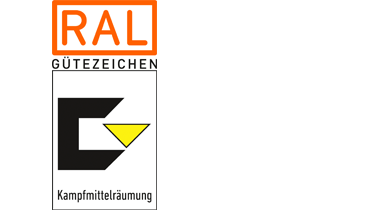Generally speaking, separation is carried out in cases where the area is highly contaminated (approx. > 2 suspected UXOs per m²) using a sifting plant. All separation procedures must comply with the provisions of the BGI 833 safety guidelines.
Before excavating the area to be cleared, the terrain should be surveyed layer by layer for large foreign objects, and any found must be cleared one by one.
The area contaminated with explosive ordnance has to be excavated layer by layer in accordance with the provisions of DIN 4124. The base of each layer must be surveyed and any large foreign objects cleared from the area.
Excavation is performed working from the side onto an uncontaminated area. Depending on the degree to which the explosive ordnance can be handled, the soil may be excavated using spades, or using an excavator to spread the soil, or by mechanically separating or sifting the soil. Active and/or passive sensors may be used if necessary. The area that was used for treating the excavated material must be surveyed again and cleared of any remaining explosive ordnance after all processing is finished.
On completion of this process, the base and walls of the excavation pit are examined using active and/or passive sensors until the required quality is achieved.
Depending on the type of explosive ordnance and the number of foreign objects, clearance may be carried out by turning over the entire area and then using mechanical separation by means of magnetic separators (permanent magnet) and – in the case of non-ferrous metals – additionally with eddy current separators. The generally applicable procedures must be observed during these operations. If separation equipment is deployed, the outlet of the plant should be closely monitored to ensure that clearance has been successful. In certain cases, a geophysical survey may also prove useful.
Separation equipment generally comprises sifting plants combined with metal separators, such as magnetic separators (permanent magnet) or eddy current separators and protective equipment.
Separation equipment must only be used if the quantity of explosives does not exceed 100 g per munition item. The calibre diameter of the munitions and shrapnel (submunitions) must not exceed 5 cm, as they are then calculated to contain less than 100 g of explosives, as a rule. This can be achieved by filtering (restricting) the infeed size of the separation equipment or by first clearing any large-calibre munitions.



